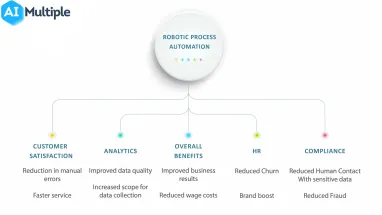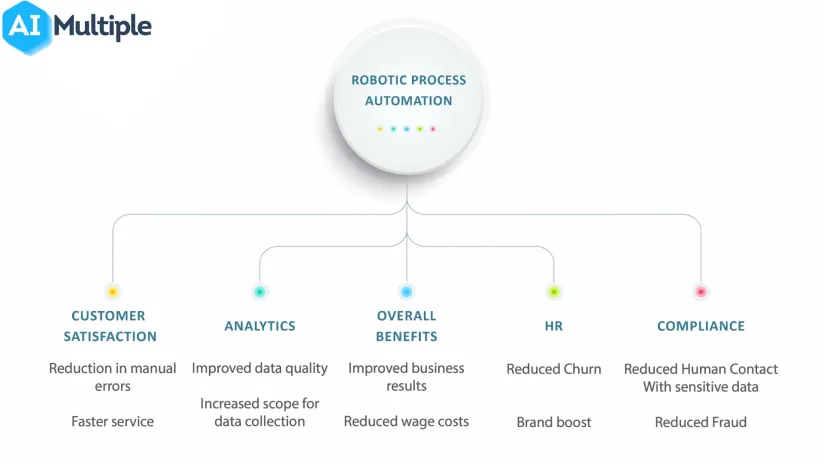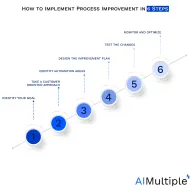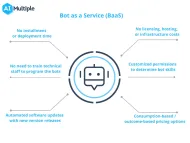RPA Benefits: 20 Ways Bots Improve Businesses in 2024


RPA has achieved phenomenal growth in the past years due to its significant capabilities in automating important business tasks, and its ease of implementation.
However, ~20% of executives surveyed by IBM have yet to establish plans to retrain or re-skill their workforce to work with RPA. Lack of clarity about RPA benefits leads to this situation.
In this article, we explore the top 20 RPA benefits compiled from vendors and end users.
What are the overall RPA benefits?
1. Improved business results
RPA both directly and indirectly improves business results:
- Thanks to its efficiency, accuracy, and 24/7 availability, it improves the quality of processes.
- By taking over tasks that were previously delegated to humans, it reduces their workload and allows them to focus on value-added activities which can boost the top or bottom line.
2. Increased focus on higher value activities
As RPA takes over tasks, it creates opportunities for business teams to focus on higher value added ones. For example, sales development reps can automate mundane activities like searching for prospects’ contact information or sending personalized messages to prospective leads. This would allow them to spend more time on the phone with prospects.
Similarly, for instance in accounting, the staff need to spend time on report creation. After RPA automates financial reporting, the finance team can focus on analyzing reports and generating insights.
RPA bots giving people time for in-depth analysis is one catalysts behind RPA creating new jobs.
3. Reduced wage costs
Deloitte estimates that, on average, 20% of FTE capacity could be replaced by bots. Those who have implemented RPA are more positive: They claim the capacity to be around 52%.
For example, a bank leveraged RPA to automate their foreign trade finance payment processes. This resulted in a reduction of full-time employees in trade finance department from 110 to 47, which cut the salary budget by over 50% in the process.
What to do about job disspossession?
Leading AI experts like Andrew NG also predict that AI will lead to job loss of workers employed in “automatable jobs” who lack the skills to be successful at jobs that can not be automated.
Businesses can tackle such issues by:
- Employing personnel in other functions: If relevant relevant opportunities exist in the company that fit these employees’ skills, they could be placed there.
- Upskilling personnel: Staff can be retrained, upskilled, and be placed in new positions in the company.
- If such opportunitie do not exist in the company, then staff who are at the risk of dispossesion should be provided with a generous severance package and the opportunity to upskill themselves and work in a different environment.
Note that even when the current headcount preserved, enabling automation will make your personnel aware of automation opportunities and keep departments lean.
4. Improved ROI
Businesses that have correctly implemented RPA have reported significant improvements in ROI. McKinsey has estimated that automating business tasks via RPA offers a potential ROI of 30–200% within the first year alone.
Learn more about how to measure RPA’s implementation success.
5. Reduced risk
System upgrades tend to go over budget and under deliver.
RPA projects are low-risk, non-invasive projects that can be implemented quickly in rules-based, repetitive, and structured processes without disturbing existing legacy systems. So there’s minimal infrastructure risk.
In addition, RPA bots reduce operational risks by reducing the risk of manual errors (e.g. duplicate or outdated data, unauthorized access to privileged data, undiscovered cyber threats).
Case study:
For example, a financial services provider leveraged RPA to automate processes in:
- Audit
- Assurance
- Tax
- Consulting
- Cybersecurity
- Privacy
They claim that a single RPA bot was able to:
- Complete the tasks of one or more employees,
- And that they were able to entirely eliminate quality-check and risk management effort across rule-based tasks.
The result was $8M of savings in annual risk management costs.
6. On-time process execution
RPA bots can be scheduled to initiate a process on a certain day of every month and at a precise time.
Punctual process execution is especially important in activities which if done late, can jeopardize business continuity.
For instance, paying vendors on time (which comes under accounts payable) makes sure that theintermediate products of your BOM (bill of materials) are at your warehouse according to your production schedule. Or that you are collecting your receviables fully and timely to ensure liquidity in the short tun.
RPA bots can be programmed to:
- Initiate outgoing payments according to rules-based criteria (for instance, one day after delivery has been confirmed, or 3 days before shipping is made, etc.)
- And check company’s accounts for receivables and send follow-up emails to unpaying customers with a payment link.
What are RPA benefits to customer satisfaction?
7. Increased customer engagement
RPA enables rule-based workflows for B2C engagements. If done manually, tending to some customer grievances might fall through the cracks.
Automating the process; however, increases the likelihood that a company hears its customer base, resolves their issues, and acts upon their suggestions.
For instance, in customer service, companies can create RPA-enabled chatbots that can conduct a conversation with a customer as a human rep would.
8. Reduction of data entry errors into customer data
A 2021 survey revealed that error-reduction is the second most important benefit of RPA after automation of manual tasks.
This is because human errors and low-quality data are estimated to cost businesses billions of dollars each year. Leveraging RPA can provide better quality data, as bots do not miss or duplicate data, and generate event logs for further analysis and audit.
Case study:
For example, a bank leveraged RPA to automate its:
- Document ordering
- Data entry
- Data verification
The initiative resulted in significant error reduction and saved the bank $1M in annual costs.
However, this does not mean that RPA provides error-free operation. RPA is not suitable for all processes, and edge cases that were not part of test cases have the potential to cause RPA bots to malfunction. RPA operations should be checked from time to time to ensure that edge cases are also covered successfully by RPA bots.
9. Faster service
It’s estimated that employees spend 10%-25% of their time on repetitive tasks, and IT teams may spend 30% of their time on basic, low-level ones. This significantly reduces time efficiency and efficacy. Leveraging RPA to automate rule-based tasks such as data entry, reporting, or generating mass email, increases the speed that these processes are done at.
Another example, in one of the process mining case studies, Piraeus Bank was able to reduce loan application processes from 35 minutes to 5 minutes by using RPA and process mining tools.
What are RPA benefits to technology units?
10. Reduced IT workload
As business users are empowered to automate their processes, IT will get fewer small automation requests.
By leveraging worklod automation (WLA) and RPA together, businesses can reduce IT workload for scheduling, initiating, and monitoring workflows on several business platforms.
Specifically, workload automation use cases in IT include:
- ETLs
- FTPs
- Data warehouse management
- SLA management
- KPI monitoring
- Cloud management/provisioning
- Workflow lifecycle management
Learn more about IT process automation.
11. Improved focus on IT innovation
IT teams spend ~30% of their time on repetitive, mundane tasks, such as data entry, reporting, and solving rule-based helpdesk issues.
Leveraging RPA in IT services, such as:
- Data and network management
- System updates
- Employee onboarding
- Employee offboarding
Enables IT teams to focus on high-value tasks. For example, research has shown that employees who had more free time due to automation focused on innovation, accepting new challenges at work, and developing their skills.
While focus is key for any department, it’s especially critical for IT as it has the challenging task of serving all departments. Having less automation-related work allows IT to focus on more important technology problems, such as finding ways to better align technology with business goals.
What are RPA benefits to analytics?
12. Improved data quality
Reduction in manual errors leads to higher quality data, enabling more reliable analyses.
Case studies reveal that RPA can improve data quality as it can extract and manipulate data at ~99% accuracy, compared to 62% when data was extracted manually.
Additionally, RPA can contribute to better analytics by providing metadata for analyzing RPA performance, as well as enabling analytics tools to access to data in legacy systems.
13. Increased scope for data collection
Robots interact with legacy systems and web browsers uncovering data that was previously labor-intensive to extract. RPA automates data entry and data extraction enabling the analytics team to develop more accurate analyses.
For example, RPA can be used to collect web data in order to provide businesses with real-time competitors’ prices, help them protect their brand, and monitor consumer sentiments.
Learn more about web scraping applications to explore web data benefits and use cases.
14. Reduced workload
Data science and analytics teams spend ~80% of their time on data collection and cleaning tasks.
Automating data collection via RPA, as well as automating the reporting of data can be especially valuable for the data science and analytics department, allowing them to focus on more sophisticated, custom analysis, and development of business models.
Benefits to HR
15. Increased employee satisfaction
A 2021 survey by salesforce revealed that:
- 89% of employees are more satisfied with their job
- And 84% are more satisfied with their company, as a result of using automation in the workplace.
Employees have also reported that automation has provided them with more time to:
- Learn new skills
- Take on new challenges and projects
- Deepen relationships with customers and stakeholders
16. Efficient change management
Change management refers to any change that’s made to a process. For instance, a purchasing manager might want to switch suppliers. He/she has to submit a request to their immediate superior, with the reason why, and alternative vendors.
Companies can leverage RPA bots to automate their change management. For instance, instead of the manual submission of the change request form, employees can fill digital documents and the OCR and NLP-driven RPA bots can read, evaluate, and provide a preliminary assessment of the urgency of the issue.
The benefit is that the end-to-end process of change management can be made more efficient and quicker.
17. Reduced churn
A 2020 EY survey revealed that 20-30% of employees who do repetitive tasks leave their jobs annually, requiring businesses to hire a new workforce every year, which is more expensive.
Leveraging RPA to automate repetitive mundane tasks will reduce this rate as employees will be more satisfied while focusing on higher-value tasks.
As an example, a 2021 research study found that automation created autonomy and job-crafting opportunities. The study also indicated that employees who were allowed more time (thanks to RPA automating their mundane tasks):
- Found more opportunities to engage in internal and external collaboration and working relationships,
- Re-develop services, think about, and/or solve more complex work-related problems, which can result in value-adding solutions and innovations.
Over time, automation will reduce the speed at which you hire for growth. As a result of this efficiency increase, you will be managing a more lean and mean workforce.
18. Reduced hiring costs
This is an indirect effect but reducing manual labor boosts satisfaction and makes a company more attractive, thus facilitating hiring.
For example, a UK-based company leveraging RPA for operations automation was able to cut down on the cost of recruitment and training of 22 staff members.
Compliance benefits
19. Minimizing exposure to sensitive data
Automating sensitive data processes via RPA minimizes human contact with that data, reducing the probability of fraud and compliance issues.
For example, a US-based bank leveraged RPA for optimizing anti-money laundering processes for KYC automation, periodic client reviews, and suspicious activity monitoring.
The results were increased regulatory compliance 75% savings on due-diligence costs.
20. Maintaining an audit trail
RPA bots generate event logs of the processes they automate, creating accurate audit trails in case issues arise.
For example, a telecommunication company leveraged RPA for automating maintenance processes. This resulted in a 78% reduction in maintenance efforts and improved IT audit quality due to detailed event log records.
See our article about compliance automation to explore use cases in detail.
Moving on to RPA implementation
Companies essentially face 2 options to minimize effort for repetitive tasks that require little human judgment:
- Upgrade existing legacy systems to modern ones which enable automation
- Use bots to interface with legacy systems and automate these tasks
If you choose the second option because of the cost or schedule of system upgrades, you need to choose an RPA partner. You can download our whitepaper on how to picking an RPA technology partner:
We have an in-depth guide for comparing RPA vendors and a complete list of RPA products. If you are not clear about how to choose the right RPA product, we can also help you find the right RPA vendor for your business:
And don’t forget to download our RPA whitepaper to learn more about the topic:

Cem has been the principal analyst at AIMultiple since 2017. AIMultiple informs hundreds of thousands of businesses (as per similarWeb) including 60% of Fortune 500 every month.
Cem's work has been cited by leading global publications including Business Insider, Forbes, Washington Post, global firms like Deloitte, HPE, NGOs like World Economic Forum and supranational organizations like European Commission. You can see more reputable companies and media that referenced AIMultiple.
Throughout his career, Cem served as a tech consultant, tech buyer and tech entrepreneur. He advised businesses on their enterprise software, automation, cloud, AI / ML and other technology related decisions at McKinsey & Company and Altman Solon for more than a decade. He also published a McKinsey report on digitalization.
He led technology strategy and procurement of a telco while reporting to the CEO. He has also led commercial growth of deep tech company Hypatos that reached a 7 digit annual recurring revenue and a 9 digit valuation from 0 within 2 years. Cem's work in Hypatos was covered by leading technology publications like TechCrunch and Business Insider.
Cem regularly speaks at international technology conferences. He graduated from Bogazici University as a computer engineer and holds an MBA from Columbia Business School.
To stay up-to-date on B2B tech & accelerate your enterprise:
Follow onNext to Read
Top 4 Cost-Effective RPA Tools Under $2,000 in 2024
Top 16 Use Cases of RPA in Education in 2024
Top 6 Open Source RPA Providers in 2024
Very interesting & well drafted Cem. Look forward to have some interesting insights on RPA ROI modelling as well 🙂
Don’t you think this is very surprising that even after lots of planning, financial analysis & smart investments, majority of organizations miss to achieve the BOT return on investment (ROI). Is this due to a lack of understanding, a lack of insight or a lack of oversight?
Thank you Satish! It is indeed a combination of factors. The issues I frequently see are:
– Lack of process understanding – can be improved by relying on process mining tools and software development best practices in RPA bot building
– Choosing processes not well suited to RPA – I still hear numerous companies use RPA in invoice processing where end-to-end domain specific solutions exist. If all you know is a hammer, everything looks like a nail
– RPA limitations such as difficulty of updating bots, over reliance of rules due to limited use of machine learning in bots
That’s a deep and insightful research, I will get back to this information from time to time thank you for posting it. It’s great that Artificial Intelligence and Robotic Process Automation already have some tangible metrics in 2019, which leads to proving business value to investors. I would like to see the AI evolve and being implemented in more use cases across all industries. RPA could be very useful in far more industries that it is in 2019, and I’m looking forward to seeing more.
The article is fantastic. You put a lot of effort into this brilliant article. Thank you so much.
Infrrd AI(https://infrrd.ai/) takes out the pain of capturing data and extracting intelligence from a plethora of documents, delivering you the information you need without having to manually go over documents one by one. The software basically saves you precious time and effort and you never have to worry about accuracy as Infrrd AI uses the latest OCR technologies and their own AI algorithms to ensure the precision of every extracted data.
Hi can I publish this on my website (in development phase).
Unfortunately, duplicate copies do not make sense as we regularly update the content. Feel free to give a link to the article so readers can have the latest version
May I quote from this Blog?
Sure, please. Would you mind letting us know where?
Hii
Great information shared about RPA. RPA if it is implemented many industries can boost their productivity and increase in ROI.
Blog was excellent to read thanks for sharing the some applications of RPA and its benefits


Comments
Your email address will not be published. All fields are required.